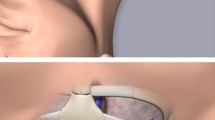Abstract
Purpose
This study was designed to assess the current use of heparinized saline and bolus doses of heparin in non-neurological interventional radiology and to determine whether consensus could be reached to produce guidance for heparin use during arterial vascular intervention.
Methods
An interactive electronic questionnaire was distributed to members of the British Society of Interventional Radiology regarding their current practice in the use, dosage, and timing of heparin boluses and heparinized flushing solutions.
Results
A total of 108 completed questionnaires were received. More than 80% of respondents used heparinized saline with varying concentrations; the most prevalent was 1,000 IU/l (international units of heparin per liter) and 5,000 IU/l. Fifty-one percent of interventionalists use 3,000 IU as their standard bolus dose; however, the respondents were split regarding the timing of bolus dose with ~60% administering it after arterial access is obtained and 40% after crossing the lesion. There was no consensus on altering dose according to body weight, and only 4% monitored clotting parameters.
Conclusions
There seems to be some coherence among practicing interventionalists regarding heparin administration. We hypothesize that heparinized saline should be used at a recognized standard concentration of 1,000 IU/l as a flushing concentration in all arterial vascular interventions and that 3,000 IU bolus is considered the standard dose for straightforward therapeutic procedures and 5000 IU for complex, crural, and endovascular aneurysm repair work. The bolus should be given after arterial access is obtained to allow time for optimal anticoagulation to be achieved by the time of active intervention and stenting. Further research into clotting abnormalities following such interventional procedures would be an interesting quantifiable follow-up to this initial survey of opinions and practice.




Similar content being viewed by others
References
Zaman SM, De Vroos Meiring P, Gandhi MR, Gaines PA (1996) The pharmacokinetics and U.K. usage of heparin in vascular intervention. Clin Radiol 51:113–116
Miller DL (1989) Heparin in angiography: current patterns of use. Radiology 172:1007–1011
Wallace S, Medellin H, De Jongh D, Gianturco C (1972) Systematic heparinization for angiography. Am J Roentgenol Rad Ther Nucl Med 116(1):204–209
Moss JG, Uberoi R, Kinsman R, Walton P (2008) Third British Society of Interventional Radiologists Iliac angioplasty and stenting report (BIAS III) audit and registries, published by Dendrite Clinical Systems
Siegelman SS, Caplan LH, Annes GP (1968) Complications of catheter angiography: study with oscillometry and “pullout” angiograms. Radiology 91:251–253
Lee KH, Han JK, Byun Y, Moon HT, Yoon CJ, Kim SJ, Choi BI (2004) Heparin-coated angiographic catheters: an in vivo comparison of three coating methods with different heparin release profiles. Cardiovasc Intervent Radiol 27(5):507–511
Nejad M, Klaper MA, Steggerda FR, Gianturco C (1968) Clotting on outer surfaces of vascular catheters. Radiology 91:248–250
Formanek G, Frech RS, Amplatz K (1970) Arterial thrombus formation during clinical percutaneous catheterization. Circulation 41:833–839
Libsack CV, Kollmeyer K (1979) Role of catheter surface morphology on intravascular thrombosis of plastic catheters. J Biomed Mater Res 13(3):459–466
Shammas NW, Lemke JH, Dippel EJ, McKinney DE, Takes VS, Youngblut M, Harris M, Harb C, Kapalis MJ, Holden J (2003) In-hospital complications of peripheral vascular interventions using unfractionated heparin as the primary anticoagulant. J Invasive Cardiol 15:242–246
Halm MA (2008) Flushing hemodynamic catheters: what does the science tell us? Am J Crit Care 17:73–76
Tuncali BE, Kuvaki B, Tuncali B, Capar E (2005) A comparison of the efficacy of heparinized and nonheparinized solutions for maintenance of preoperative radial arterial catheter patency and subsequent occlusion. Anesth Analg 100(4):1117–1121
Altenburg A, Haage P (2011) Antiplatelet and anticoagulant drugs in interventional radiology. Cardiovasc Intervent Radiol 23:1–7
Jacobsson B, Bergentz SE, Ljungquist U (1969) Platelet adhesion and thrombus formation on vascular catheters in dogs. Acta Radiol Diag 8:97
Antonovic R, Rosch J, Dotter CT (1976) The value of systemic arterial heparinisation in transfemoral angiography: a prospective study. Am J Radiol 127:223–225
British National Formulary 58. BMJ Group. September 2009
Despotis GJ, Summerfield AL, Joist JH, Goodnough LT, Santoro SA, Spitznagel E, Cox JL, Lappas G (1994) Comparison of activated coagulation time and whole blood heparin measurements with laboratory plasma anti-Xa heparin concentration in patients having cardia operations. J Thorac Cardiovasc Surg 108:1076–1082
Chew DP, Bhatt DL, Lincoff AM et al (2001) Defining the optimal activated clotting time during percutaneous coronary intervention: aggregate results from 6 randomized, controlled trials. Circulation 103:961–966
Beguin S, Lindhout T, Hemker HC (1988) The mode of action of heparin in plasma. J Thromb Hemost 60:457–462
Hirsh MD, Warkentin TE, Shaughnessy SG, Anannd SS, Halperin JL, Raschke R, Granger C, Ohman EM, Dalen JE (2001) Heparin and low molecular weight heparin mechanisms of action, pharmacokinetics, dosing, monitoring, efficacy and safety. Chest 119:645–945
Conflict of interest
None.
Author information
Authors and Affiliations
Corresponding author
Appendix 1: Heparin Survey
Appendix 1: Heparin Survey
Rights and permissions
About this article
Cite this article
Durran, A.C., Watts, C. Current Trends in Heparin Use During Arterial Vascular Interventional Radiology. Cardiovasc Intervent Radiol 35, 1308–1314 (2012). https://doi.org/10.1007/s00270-011-0337-1
Received:
Accepted:
Published:
Issue Date:
DOI: https://doi.org/10.1007/s00270-011-0337-1






